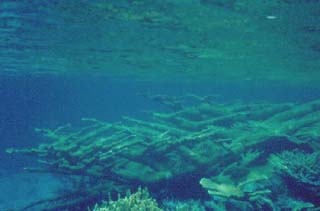A hurricane is a type of tropical cyclone that forms over warm tropical waters (80 æF or higher) where the winds are light and the humidity is high. It starts as a tropical disturbance and can grow to become a hurricane as long as the above conditions are maintained. Heavy thunderstorms and tremendously strong winds are generated from hurricanes. The strong winds can stir below the sea surface, and thus tear apart coral reefs.
This disturbance is an integral part of the natural dynamics of a coral reef. A healthy reef can recolonize rapidly with availability of larvae from existing adult colonies.
It had been almost 40 years since a major storm directly impacted coral reefs around Jamaica. In the 1980s, two category five storms inflicted heavy damage on Jamaica.
- Hurricane Allen, 1980 (Category 5)
- Hurricane Gilbert, 1988 (Category 5)
(stormcarib.com/climatology/wcar_isl.htm)
- Considering the images below, how do you think presence of macroalgae affect coral reef recovery following a hurricane?
|
|
Bleaching occurs when densities of zooxanthellae decline and/or the concentration of photosynthetic pigments within the zooxanthellae drop. The pale appearance of the bleached coral is due to the white, calcareous skeleton showing through the translucent tissue of the polyps that is devoid of pigmented zooxanthellae.
The coral may regain its zooxanthellae population within several weeks or months if the bleach-causing stress decreases. However, if the stress condition is prolonged the coral host will eventually die.
There are many stresses that can induce bleaching:
- rapid freshwater dilution, like from heavy rain
- exposure to elevated concentration of various contaminants (e.g. Cu and herbicides) arising from island run-off
- increase in ambient nutrient concentration (e.g. NH4+ and NO3-), can arise from island run-off
- sedimentation from run-off and sewage out-falls
- subaerial exposure due to extremely low tides, sea level drops, and tectonic lifts
- increase in solar radiation, i.e. sunburn
- increase sea surface temperature
(Hoegh-Guldberg andSmith, 1989; Williams and Bunkley-Williams, 1990; Glynn, 1996)
There has been unprecedented increase in coral reef bleaching reported beginning in the 1980s. Since then, there has been reports of at least three major bleaching events in Jamaica. Small-scale, localized bleaching activities were also reported in Jamaica's reefs througout this time period.
- 1987. Due to prolonged sea surface temperature increase.
- 1989.
- 1990.
- 1995. Most severe in Jamaican history.
- 1997 to 1999. Global bleaching event following the 1997-98 El Nino and 1998-99 La Nina, which dramatically increased and decreased, respectively, sea surface temperatures in tropics worldwide.
|
- 1980.
- short-lived bloom followed Hurricane Allen
- 1983 to
mid 1990s.
- Prolonged bloom of benthic algae, i.e. algae attaching to sea floor
- Algae
initially composed of small, short-lived species, but these were
replaced within 2 to 3 years by longer lived species that form extensive
mats all over sea floor.
- The algae attach themselves to any hard surface on the sea floor, e.g. rock, dead coral
- 1982-1982.
Species-specific pathogen attacked Diadema antillarum throughout
its entire range.
- More than 90% of the sea urchin population throughout the Caribbean died.
- Diadema populations initially showed recovery within the first few months following the outbreak, but then recovery stopped. The population still remain low throughout the Caribbean.
- 1996. Black-band and yellow-band disease locally destructive on corals
This web site was created by Lynn Tran at the North Carolina State University, Department of Mathematics, Science, and Technology Education on 7/12/03. Faculty advisor Dr. David Eggleston, NCSU, Department of Marine, Earth, & Atmospheric Sciences. Last updated December 29, 2003 .


